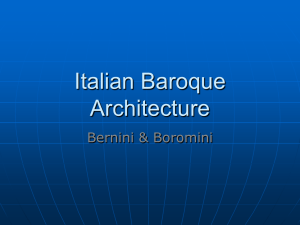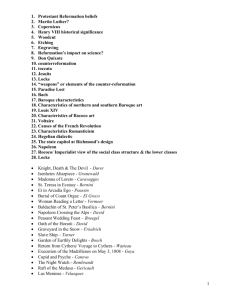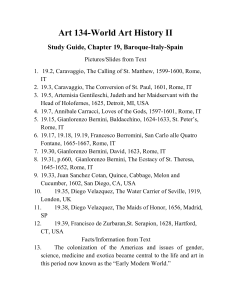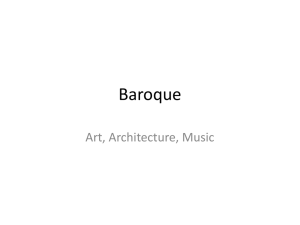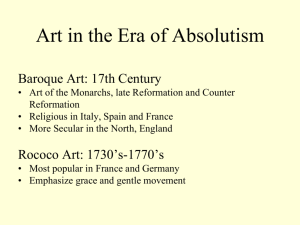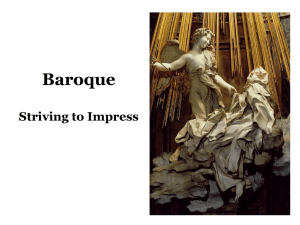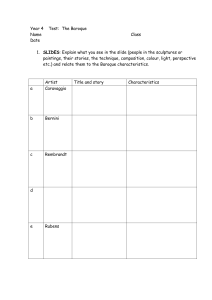Sample - solutionmanual center
advertisement
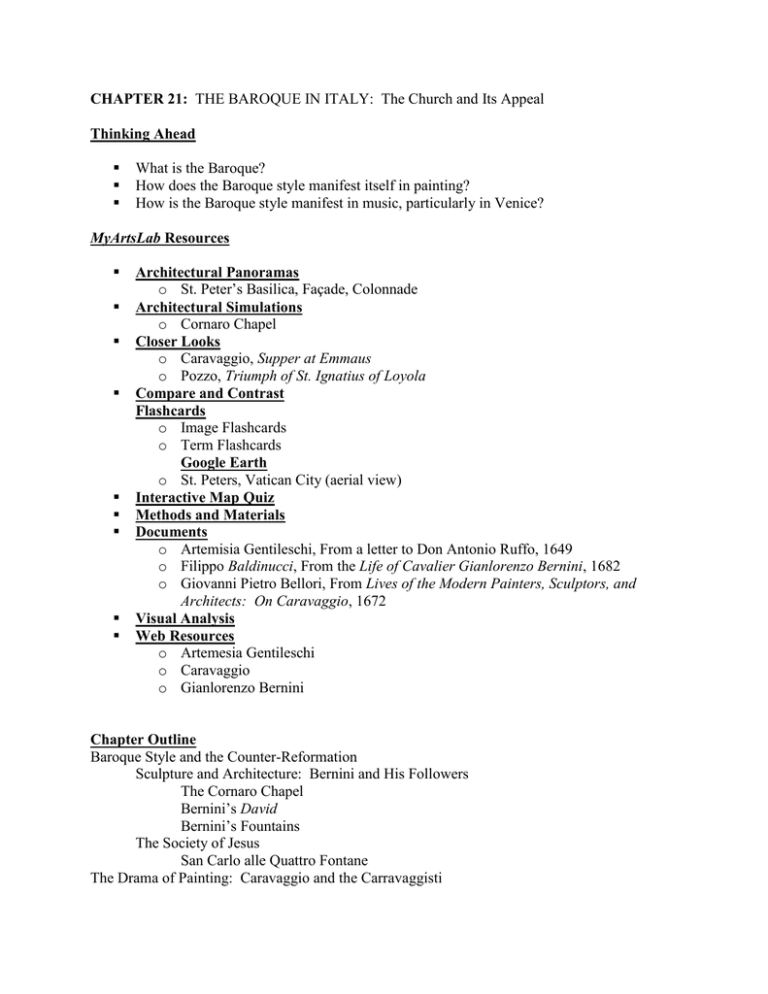
CHAPTER 21: THE BAROQUE IN ITALY: The Church and Its Appeal Thinking Ahead What is the Baroque? How does the Baroque style manifest itself in painting? How is the Baroque style manifest in music, particularly in Venice? MyArtsLab Resources Architectural Panoramas o St. Peter’s Basilica, Façade, Colonnade Architectural Simulations o Cornaro Chapel Closer Looks o Caravaggio, Supper at Emmaus o Pozzo, Triumph of St. Ignatius of Loyola Compare and Contrast Flashcards o Image Flashcards o Term Flashcards Google Earth o St. Peters, Vatican City (aerial view) Interactive Map Quiz Methods and Materials Documents o Artemisia Gentileschi, From a letter to Don Antonio Ruffo, 1649 o Filippo Baldinucci, From the Life of Cavalier Gianlorenzo Bernini, 1682 o Giovanni Pietro Bellori, From Lives of the Modern Painters, Sculptors, and Architects: On Caravaggio, 1672 Visual Analysis Web Resources o Artemesia Gentileschi o Caravaggio o Gianlorenzo Bernini Chapter Outline Baroque Style and the Counter-Reformation Sculpture and Architecture: Bernini and His Followers The Cornaro Chapel Bernini’s David Bernini’s Fountains The Society of Jesus San Carlo alle Quattro Fontane The Drama of Painting: Caravaggio and the Carravaggisti Master of Light and Dark: Caravaggio Elisabetta Sirani and Artemisia Gentileschi: Caravaggisti Women Venice and Baroque Music Giovanni Gabrieli and the Drama of Harmony Claudio Monteverdi and the Birth of Opera Arcangelo Corelli and the Sonata Antonio Vivaldi and the Concerto Topical Lecture Suggestions 1. Using the Conaro Chapel as a source (MyArtsLab), discuss the central role of theatricality in Italian Baroque Style. Gianlorenzo Bernini created the decoration of the Cornaro chapel from 1642 to 1652. Bernini’s design integrates painted areas, marble and stucco sculpture, and extensive architectural ornamentation in a manner characteristic of the Italian Baroque style. Bernini covered the walls with multicolored marble panels and crowned them with a projecting cornice supported by marble pilasters. Bernini sculpted the Spanish saint Teresa of Avila for placement in the niche. The figure of Teresa seems to float upward on clouds of stucco, which is a moistened mixture of lime and marble dust that can be molded. She is shown swooning in ecstasy upon being pierced with an arrow by an angel. The sculpted group is presented as if on a theatrical stage, further dramatized by a concealed window that allows light to stream from above. The chapel is conceived as a theater of the spirit, with members of the Cornaro family watching the Ecstasy of St. Teresa as if it were a theatrical event. The gestures and composition of this sculpture furthers the point. 2. Discuss the revolutionary innovations of Caravaggio’s style, and his influence. Both the dramatic contrasts of light and dark, and the theatrical compositions of figures spotlighted in the foreground, can be shown in visual analyses of some of the images addressed in this chapter. There is drama, intensity, and a virtual insistence that the viewer become a physical and psychological participant in the action. Strong facial expressions, and the extreme emotionalism of the moment being depicted, are picked up by Gentileschi in her Judith and Holofernes paintings. Sirani builds on Caravaggios’s depiction of holy events as everyday moments among ordinary people. 3. Explain the distinctively Baroque suggestiveness of ceiling painting. Self-conscious and deliberate theatricality of presentation is the key feature. Ceiling painting, as shown in Pozzo’s Triumph of Saint Ignatius of Loyola, breaks open the bonds of spatial and perspectival constraints to look upward to the infinity of heaven. Consider the especially strong appeals to movement through space and time in this genre and subject matter. Address the need for the view to be at a specified point to align with the scene. Discussion Suggestions 1. What features of his work made Bernini so popular, and so expressive of the spirit of his time? First, Bernini’s works appeal to universal human experience, as in the implied sexuality of Ecstasy of St. Teresa. They present this experience with energy and vivacity, selecting a key moment of activity, as in his David, for strong emotional and visceral appeal. Even the colonnade of Saint Peter’s represents an embrace of all the Faithful. The same can be said of his public works, such as the fountains and the fireworks. His works are affirmative in spirit, expressing that expanded sense of time and space so important in this era. Finally, his superb technical mastery of his medium makes his work impressive and compelling. 2. How is the new musical genre of opera especially illustrative of Italian Baroque qualities? Opera evolved as an expression of interest in ancient Greek drama, in which lines were chanted in formal tones and rhythms. The configurations of the music were tose of the time, however, just as biblical figures in painting were often clad in contemporary styles. The newly enriched component of musical harmony had great significance, and initiated a tension between the primacy of the words and the primacy of the music. This rich interdisciplinary environment is very much like the play of sculpture and theater in the Cornaro chapel. Likewise, the dramatic highlighting of a solo singing voice through the use of basso continuo makes for a different kind of drama and rhetorical effect. It also establishes a foundation for emphasis on virtuoso performers. Critical Thinking Questions 1. How does Baroque music differ from the music of the Renaissance? Renaissance music tends to be stable and steady in its rhythms, dynamics, and timbre. In the Baroque, Giovanni Gabrieli took the lead in writing emotionally moving sacred music. He employed drama and contrast by playing off choral forces and instruments against one another, and by using counterpoint effects. He specified orchestration and dynamics for his compositions to establish these effects. This style is the basis of Baroque music. Delineating a solo voice or instrument with basso continuo is another element of the style, as Monteverdi did in his operas. Both the sonata da camera and the sonata da chiesa are organized in sections (“movements”) that contrast dance rhythms, tempi, and ornamented melodic lines for soloists. And the concerto, of which Vivaldi is the master, sets off solo performers against the ensemble. 2. What architectural features constitute the “grandeur” of Saint Peter’s? The scale of the building, the use of monumental architectural features, and the size of the interior space all reflect “grandeur.” The façade suggests a proportional arrangement, yet is much larger than previous designs, while the interior and plan assume a large number of people, and the intention of asserting the church’s heroic power.
